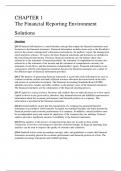Exam (elaborations)
Solution Manual For Intermediate Accounting 3rd Edition by Elizabeth A. Gordon, Jana S. Raedy, Alexander J. Sannella 2024 | All Chapters A+
- Course
- Institution
- Book
Solution Manual For Intermediate Accounting 3rd Edition by Elizabeth A. Gordon, Jana S. Raedy, Alexander J. Sannella 2024 | All Chapters A+ CHAPTER 1 The Financial Reporting Environment Solutions Questions Q1-1 Financial information is a much broader concept than simply the financial statement...
[Show more]




